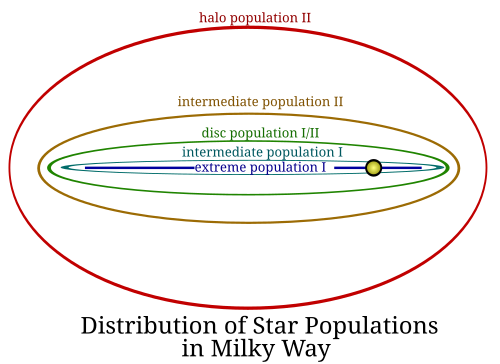http://en.wikipedia.org/wiki/Population_I_stars#Population_I_stars wrote:
<<In astronomy and physical cosmology, the metallicity (also called Z) of an object is the proportion of its matter made up of chemical elements other than hydrogen and helium. Since stars, which comprise most of the visible matter in the universe, are composed mostly of hydrogen and helium, astronomers use for convenience the blanket term "metal" to describe all other elements collectively. Thus, a nebula rich in carbon, nitrogen, oxygen, and neon would be "metal-rich" in astrophysical terms even though those elements are non-metals in chemistry. This term should not be confused with the usual definition of "metal"; metallic bonds are impossible within stars, and the very strongest chemical bonds are only possible in the outer layers of cool K and M stars.
The metallicity of an astronomical object may provide an indication of its age. When the universe first formed, according to the Big Bang theory, it consisted almost entirely of hydrogen which, through primordial nucleosynthesis, created a sizeable proportion of helium and only trace amounts of lithium and beryllium and no heavier elements. Therefore, older stars have lower metallicities than younger stars such as our Sun.
Stellar populations are categorized as I, II, and III, with each group having decreasing metal content and increasing age. The populations were named in the order they were discovered, which is the reverse of the order they were created. Thus, the first stars in the universe (low metal content) were population III, and recent stars (high metallicity) are population I.
While older stars do have fewer heavy elements, the fact that all stars observed have some heavier elements poses something of a puzzle, and the current explanation for this proposes the existence of hypothetical metal-free Population III stars in the early universe. Soon after the Big Bang, without metals, it is believed that only stars with masses hundreds of times that of the Sun could be formed; near the end of their lives these stars would have created the first 26 elements up to iron in the periodic table via nucleosynthesis.
It has been proposed that recent supernovae SN 2006gy and SN 2007bi may have been pair-instability supernovae in which such super-massive Population III stars exploded. It has been speculated that these stars could have formed relatively recently in dwarf galaxies containing primordial metal-free interstellar matter; past supernovae in these galaxies could have ejected their metal-rich contents at speeds high enough for them to escape the galaxy, keeping the metal content of the galaxy very low.
The next generation of stars was born out of those materials left by the death of the first. The oldest observed stars, known as Population II, have very low metallicities; as subsequent generations of stars were born they became more metal-enriched, as the gaseous clouds from which they formed received the metal-rich dust manufactured by previous generations. As those stars died, they returned metal-enriched material to the interstellar medium via planetary nebulae and supernovae, enriching the nebulae out of which the newer stars formed ever further. These youngest stars, including the Sun, therefore have the highest metal content, and are known as Population I stars.
Across the Milky Way, metallicity is higher in the galactic centre and decreases as one moves outwards. The gradient in metallicity is attributed to the density of stars in the galactic centre: there are more stars in the centre of the galaxy and so, over time, more metals have been returned to the interstellar medium and incorporated into new stars. By a similar mechanism, larger galaxies tend to have a higher metallicity than their smaller counterparts. In the case of the Magellanic Clouds, two small irregular galaxies orbiting (see note about newest research) the Milky Way, the Large Magellanic Cloud has a metallicity of about forty per cent of the Milky Way, while the Small Magellanic Cloud has a metallicity of about ten per cent of the Milky Way.>>
 In the Arms of M83
In the Arms of M83


